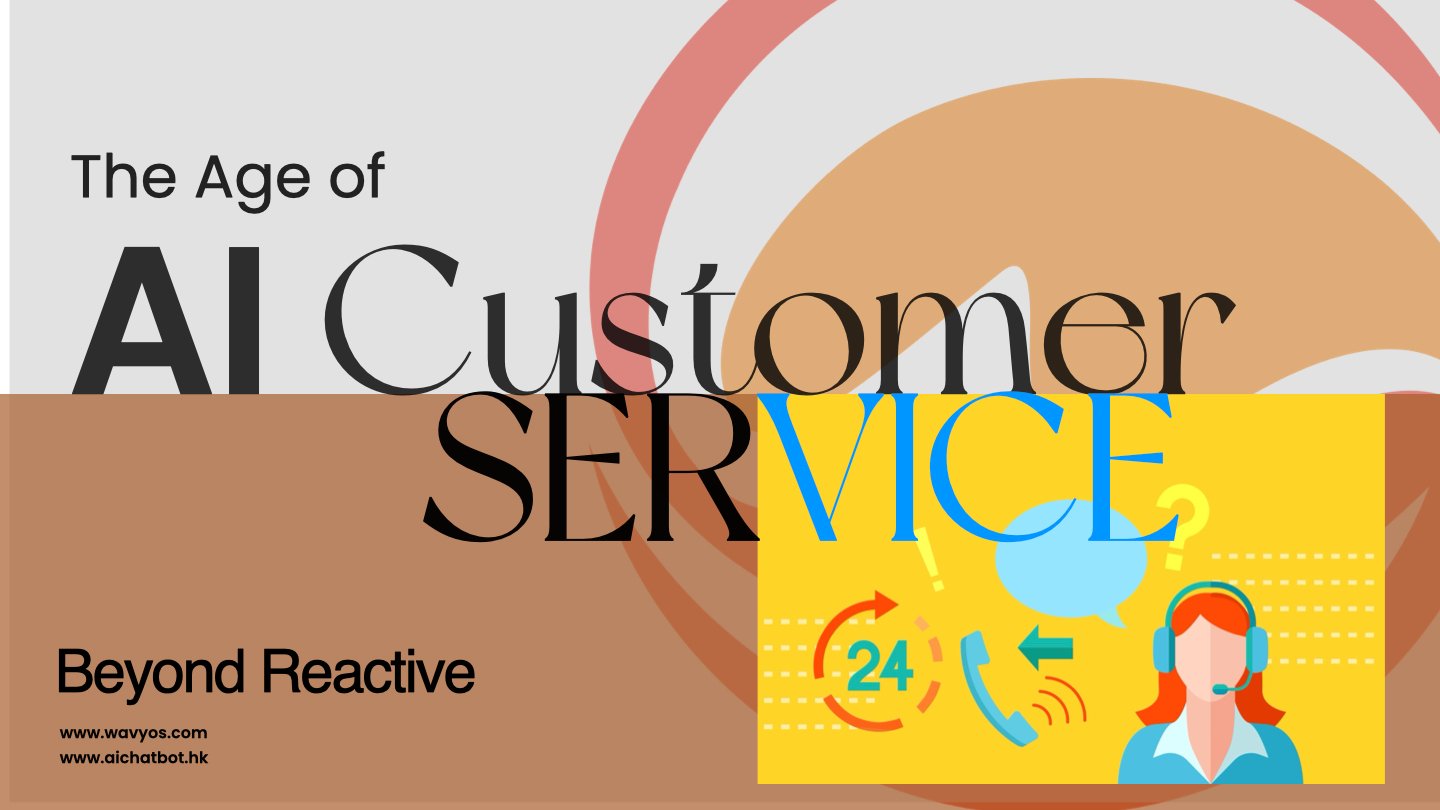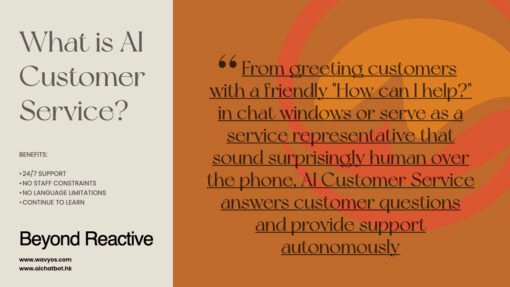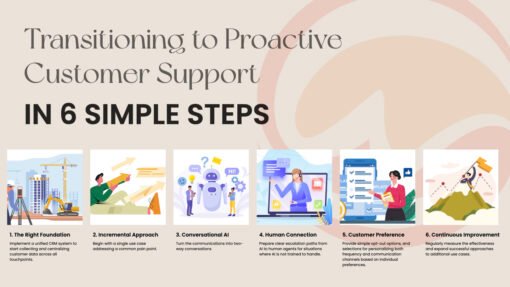Beyond Reactive: The Age of AI Customer Service

The Age of AI Customer Service
Despite the high costs, tedious preparation work and staff training, businesses could once rely on direct mail and phone call to reach out to nearly all of their customers. But apparently in today’s fragmented communication ecosystem this approach is highly ineffective. Nowadays customers are scattered across numerous platforms and channels. They are navigating between different social media, messaging apps, email, and other emerging platforms. Maintaining efficiency and consistent quality in customer service and marketing outreach presents both unprecedented challenges and opportunities. Such diversification of communication channels does not just drive businesses for a fundamental steering of their customer service and marketing support structure, they must also develop sophisticated frameworks that adapt to multiple channels while preserving their brand voice and service standards.
At this point when organizations struggle to staff and manage expertise across these varied touchpoints, AI customer service emerges as a compelling solution. Practically AI customer service can offer scalable, consistent engagement regardless of communication channels and platforms. What businesses need to consider though, this technological shift demands equally innovative and forward-thinking to ensure these AI systems truly deliver the personalized, responsive service modern customers expect.
What is AI Customer Service?
AI chatbots are becoming the first line of contact in many organizations. From greeting customers with a friendly “How can I help?” in chat windows or serve as a service representative that sound surprisingly human over the phone, these intelligent digital systems answer their questions autonomously, provide guidelines, triage issues, and even resolve customer problems without human intervention.
The benefits of AI Customer Service
The benefits are obvious. AI customer service provides 24/7 support without the constraints of staffing requirements, break hours, language limitations, or educational backgrounds. Customers can get help anytime, anywhere.
While service quality is not likely to be magically improved overnight, AI’s ability to handle multiple inquiries simultaneously will for sure eliminate frustrating wait time for customers. And given the more predictable and consistent responses provided by AI than human variability and emotions, all customers are going to receive the same high-quality information regardless of when they reach out or what they need.
More importantly AI customer service will evolve continuously through machine learning over time. And by accumulating vast customer data at each interaction, these systems not only become more intelligent but develop insights into customer needs that no individual staff member could possibly match.
Make no mistakes though, human supervision remains essential. AI is not here to replace human staff. Instead they can focus on more complex issues requiring empathy and creative problem-solving that machines cannot provide.
Elevating Customer Service: Reactive vs. Proactive Approaches
We have covered handling of customer complaints, solving problems, and answering inquiries as when customers initiate contact. Collectively these are known as Reactive Customer Service. Primarily it deals with post-purchase support and issue resolution. It addresses issues after they occur. Every thriving business must provide such fundamental level of customer service. Unquestionably customers will abandon a business that fails to respond to their requests for assistance promptly. This is the entry-level customer service critical for all businesses to maintaining basic customer relationships.
To take a step further and truly elevate customer experience, businesses must anticipate customer needs, offer solutions before customers ask and proactively engage customers about their latest offers and promotions. These strategic moves or communications includes sending maintenance reminders, notifying reward point expiry, making personalized recommendations and gathering feedback to improve products and services.
While reactive service fixes existing problems of the customers, proactive customer service enhances customer’s experience and their brand loyalty by showing you’re preparing ahead about their interests and helping them maximize value from their relationship with your business.
Proactive Customer Service Is Vital to Businesses
Proactive customer service is vital to businesses for a number of compelling reasons:
- Preventing Problems: Anticipates and resolves issues before customers experience them, reducing complaint volume.
- Building Customer Loyalty: Shows customers you value their business enough to think ahead about their needs.
- Creating Competitive Advantage: Differentiates your business in crowded markets where reactive service is the norm.
- Increasing Retention: Customers stay longer with businesses that anticipate their needs and prevent frustrations.
- Driving Revenue Growth: Opens opportunities for relevant product recommendations and service upgrades.
- Improving Efficiency: Reduces support costs by addressing potential issues systematically rather than individually.
- Enhancing Brand Reputation: Positions your company as customer-focused and forward-thinking.
What stops businesses from doing proactive customer service?
Despite the tremendous benefits proactive customer service brings to businesses and organizations, yet only a few of them are doing it consistently. One main reason is obviously lack of resources. However, consider how you maintain friendships. You can’t rely solely on social media. You need to call or at least send your friends a message to check in. The same principle applies to client relationships.
Business owners often overlook a crucial point. Keeping existing customers loyal and satisfied is far more cost-effective and beneficial in the long-term. While acquiring new customers understandably takes priority, that is a hard truth no business can expand or survive without adequate new sales. But we have to bear this in mind too: acquiring a new customer may cost five to seven times more than retaining an existing one. And most significantly, repeat customers typically spend more and provide better word-of-mouth marketing over time. They are invaluable to sustainable profitability and business growth. Neglecting relationships with existing clients risks eroding your customer base. A foundation that no business can afford to lose.
Beyond resource limitations, another major obstacle possibly came from data fragmentation. Many small companies rely heavily on manual process. They operate without proper customer and order management systems. And regardless of size, numerous other businesses use what are known as “siloed systems”. These systems are separate applications that don’t share information between departments. In either scenario, these disconnected operational or management systems prevent businesses from collecting comprehensive insights, creating unified customer views, and anticipating needs across various touchpoints.
Transitioning To Proactive Customer Support in 6 Simple Steps
Proactive customer service anticipates customer needs before issues arise. By bringing your customers closer and addressing their concerns even before they experience any small form of frustration, companies can be better connecting to their customers, building trust and differentiating themselves in competitive markets. Now with the latest AI technology, transforming and upgrading your customer support to a more proactive approach has never been easier. In a few simple steps here’s how to begin:
- Laying the right foundation is your critical first step. Implement a unified CRM system to start collecting and centralizing customer data across all touchpoints. Beyond basic sales data for purchase pattern analysis and sales forecasting, businesses need to develop comprehensive customer profiles that enable personalized, customized outreach.
- As with implementing any new systems or procedures, it is always best to take an incremental approach. Begin with a single use case addressing a common pain point, such as order status updates or renewal reminders. Then test it with a small customer segment before scaling, continuously gather feedback, and measure impact against clear KPIs. While immediate sales impact may not be evident, you’re establishing meaningful engagement with your customers.
- Integrate conversational AI to assist customers and turn the communications into two-way conversations. In this case customers do not just receive plain notifications from us. Our messages could trigger their curiosity and can effectively convert our courtesy reminders into valuable sales opportunities.
- Don’t forget to balance machine automation with genuine human connection. Prepare clear escalation paths from AI to human agents for situations where AI is not trained to handle. Integrate the new AI workflows and tools into your existing customer support framework, and provide comprehensive training to ensure your team can master and get the best out of them when doing their jobs.
- Respect customer preferences in your outreach strategy. Be transparent about data usage and AI implementation, provide simple opt-out options, and selections for personalizing both frequency and communication channels based on individual preferences.
- Finally, commit to continuous improvement. Regularly measure the effectiveness of your proactive initiatives, update AI models with new customer data, and expand successful approaches to additional use cases and customer segments.
The Future Belongs to Businesses that Lead
As we enter the age of AI-powered customer service, neither of totally relying on manual process nor waiting for problems to arise is an option. Start your proactive support journey today. It is feasible for businesses of all sizes. And more accessible than you might think. You can begin with simple AI implementations that identify patterns and provide timely responses. Potential returns include increased customer retention, higher satisfaction scores, and operational savings, the ROI is undeniable.
The age of AI customer service is here. Are you going to lead or fail?
Contact us today for a free consultation. Our team will demonstrate how we can help transform your legacy support operations into a modern, intelligent and highly efficient customer experience center.
Email: sales@wavyos.com
WhatsApp: +852 6099 4407
Other topics that you might be interested in:
-
- Our website design and development, mobile app development and SharePoint services.
- AI Chatbots Aren’t Solo Artists: Essential Tools For AI Chatbot Success
- Unlocking the Full Power of Your Business with a Multilingual WordPress Website
- Our New Customizable Order Fulfillment Module for WooCommerce


